To coincide with the release of Assassin’s Creed II, Ubisoft called on Hybride to create 3 short films as a preamble to the game. In the films, assassin Giovanni Auditore is tasked with investigating the murder of the Duke of Milan in 1476, a role that takes him to Florence, Milan, Venice and the Vatican. We speak to Hybride president Pierre Raymond about completing 750 vfx shots for the films.
fxg: The short films use a real hybrid approach with live action and CG environments. What was the aim in terms of the look and feel of the films?
Raymond: There are a lot of teasers out there for computer games, so we were more interested in telling a long story as a lead-in to Assassin’s Creed II. It’s done in such a way that if the gamer is playing a game, he or she can move within the game environment and find where we put the camera for the film series. It’s that accurate. It was a very interesting experience because it had not been done before. There are not many companies bridging their game IP to the film community. We used real actors on studio greenscreen in Montreal and then generated all the environments entirely in 3D.
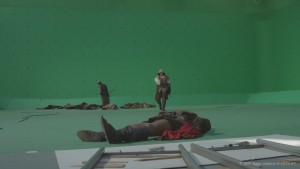
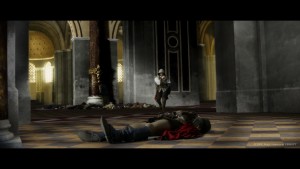
fxg: How did you go about importing those environments?
Raymond: Well, firstly the geometry from the outside world is directly imported from the game engine. Then most of the interior environments were modeled by Hybride. We wrote some software that went between UDA, which is the film division from Ubisoft, and the engineers here at Hybride, to be able to ‘borrow’ environments from the game engine, Anvil, and to propose them to the director for filming in the studio. Generally we received 4K textures and then after that it was a question for us to re-assign that. We could do more sophisticated lighting than the game engine could take so sometimes we up-rezed the environments.
fxg: How did you approach the live action shoot?
Raymond: Obviously at Hybride we are very used to shooting on greenscreen for film visual effects and then doing the compositing here at Hybride. But this time, what was more difficult was that the director was someone who liked to work with a very long lens. That created a very small depth of field. All of the tracking dots that we used very rapidly became useless because they would go out of focus and disappear in the background. So we came up with the idea of using a sister camera. This was a small camera alongside the main camera just for tracking purposes. We had this camera with a long focal giving us all of the dots in focus. When we were not able to use the master camera to extrapolate the movement, we just used the sister camera to generate a tracking file. Both cameras were locked to each other mechanically so they both moved together in exactly the same way. That helped us tremendously during the shooting and gave us the ability to shoot many more setups each day.
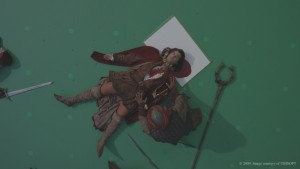
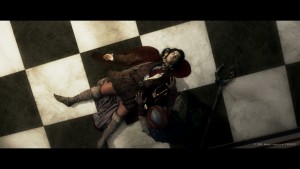
fxg: Was it an entire greenscreen set?
Raymond: Mostly. We were not allowed to use real material for the floor, which solved most of the issue of feet contact on the ground. Because of the different kind of material from one environment to another, I had to shoot with a greenscreen floor. It’s something that we always try to skip as much as possible. But because of the different environments, marble, stone, reflective, non-reflective, outside, inside – greenscreen was the best option. The problem with that can be, say if you have an exterior shot, you always have one sun and one source of light, but in a studio we had 32 spots and you are forced to erase all of the shadows you don’t need and just give priority to the one that is representing the sun.
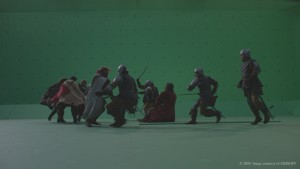
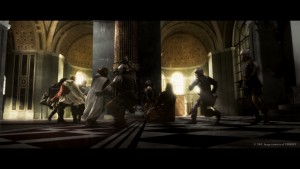
fxg: What kind of on set preview did you use?
Raymond: I had to find a way to generate some kind of system to show the actors the environments that they would be acting in that would be generated later, specifically, the stunts. They are performing in an environment that doesn’t exist yet and it’s very easy for them while acting not to be limited by a real wall that we would add later. So we used a very high projector on the set and we projected a top view of the future environment during the shooting. That was the biggest innovation as far as the shooting was concerned. It sped up the process to put accessories on a shot-by-shot basis. We were just projecting one to one on the floor and the people were just putting back the tables or chairs that we needed for the shooting.
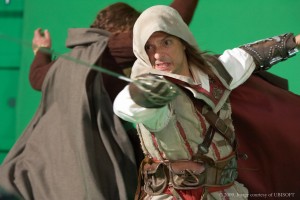
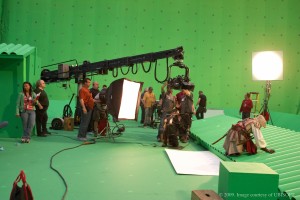
fxg: How did you come up with the look for the environments?
Raymond: We pre-comped most of the environments and previs’d most of the angles with the director. Those environments didn’t have a final look, but geometrically-speaking they were very accurate. During the shooting, we had some 3D graphics stations recalling the environments on a shot-by-shot basis. We had a preview integration of the live camera with the actors on top of the low-res versions of the future environments. It gave the director a pretty good idea of the direction we were taking. When all of that was done, we did the tracking on a shot-by-shot basis and then the layout and started to texture and light the environment on a shot-by-shot basis. We received the environment with the proper lighting and then had to integrate the characters. Our main compositing tools were Infernos and Flames, with some Fusion. The 3D package we used was Softimage.
